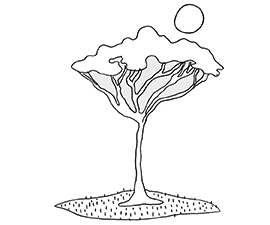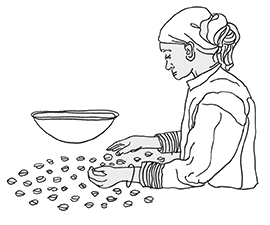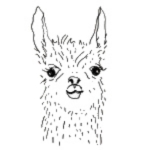About Kiamugumo AA
Kiamugumo factory is situated in the community of Ngariama in the Nyangeni subregion of Kirinyaga County, on the slopes of Mount Kenya. In this area of Kenya, smallholders deliver coffee in cherry to washing stations. Typically the climate ranges from 12 to 25 degrees Celsius year round. Production cycles follow the standard timeframe with the main crop harvested October through December/January and fly crop harvested April through June.
After harvesting, producers bring the ripe cherries to the factory in horses or motorcycles. The cherries are washed and depulped with water from the Kii River. After washing, the coffee is dried on typical African raised beds, which allow good air circulation between the beans. Beans are dried to between 11 and 13% moisture, then brought to the Central Kenya Coffee Mill in Karatina Nyeri county for grading and sorting.
Kiamugumo Coffee factory is run by a factory manager who oversees all activities within the factory. Together with other staff members they carry out duties such as weighing coffee, selection and grading of coffee, paying farmers and addressing farmers’ complaints.
In line with the rising awareness on the need to conserve the environment, the factory has dug their wastewater soak pits away from the water source where the wastewater is allowed to soak in back to the soil. Currently the factory does not engage in wastewater treatment. Additionally the society encourages its members to plant trees on their farms.
Kiamugumo has long-term goals to increase coffee production, training seminars, and access to education and sustainable processes for the farmers they work with. They also maintain a demonstration plot that farmers can visit and reference in relation to their own plots.
Kiamugumo washing station is located in the buffer zone surrounding Mount Kenya National Park. Mount Kenya is also an extinct volcano and the second highest snow-capped peak in Africa (5,199 masl), after Kilimanjaro.
The presence of this snowy mountain in Kirinyaga (the name of which actually means “White Mountain” in the native Kekuyu language) plays a fundamental role for the population and coffee of the surrounding areas. Its glaciers feed the Kii river which plays an important role in the processing of the coffee at the Kiamugumo washing station.
These glacier-fed rivers also help cool the surrounding areas, giving the farms in the county an annual temperature between 13 and 25 C—privileged temperatures compared to other coffee-growing areas in Africa.
The Ngariama area has a long chain of mountains that help provide a diversity of altitudes and terrain for coffee cultivation. While this could seem like an obstacle to access (as it is in Peru where the presence of Andes means getting to a farm can take 7+ hours by road), in Ngariama the farms are only about a 30 minute trail walk (1-2 km) from the Kiamugumo washing station. Only in the rainy season does access become complex as mud makes these unpaved trails challenging to navigate.
There is good telephone signal in the area, so the washing station usually informs farmers about the final weight of their coffee and other interesting and useful data they’ve collected.
The main economic pillar in Ngariama is coffee. Other common crops grown are banana and maize. Grevillea, macadamia, and false banana trees are also planted to provide shade to the coffee trees.
Farms in this region are surrounded by forests of native trees where wild animals such as elephants and buffalos live. Local coffee producers use fences strategically along their farm perimeters to protect their crops and minimize contact with potentially dangerous fauna. The Kenyan government has prohibited logging and hunting in the area and producers are very respectful of these rules.
The predominant population of Ngariama community are the Kikuyu, the oldest native population in the area. Everyone in the area also speaks Kikuyu.
The farms here are mostly very small (1-2 hectares) and adults work the farms while children attend school all day. Schools here cost money, which unfortunately limits access to education and future opportunities in this mostly-poor area. Due to lack of opportunity, much of the young population is migrating en masse to cities in search of better jobs, leaving their parents alone on the farms or even taking their parents and abandoning their farms. This problem gets worse each year.




